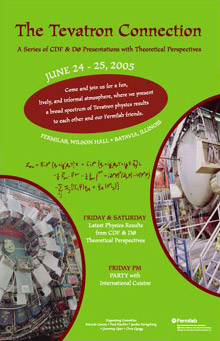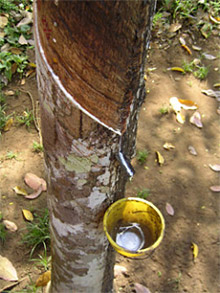 | Monday, June 20, 2005 |
|
Monday, June 20 3:30 p.m. Director's Coffee Break - 2nd Flr X-Over 4:00 p.m. All Experimenters' Meeting - Curia II Special Topic: Progress and Plans for Rapid Transfers PARTICLE ASTROPHYSICS SEMINARS WILL RESUME IN THE FALL
Tuesday, June 21 |
|
Extended Forecast |
Secon Level 3 |
|
Monday, June 20 French Quarter Gumbo Soup French Dip w/Horseradish Cream Sauce $4.85 Honey Garlic Pork Chop $3.75 BBQ Roasted Quartered Chicken $3.75 Italian Panini with Provolone $4.85 Pizza $3.00 Sweet n' Sour Chicken with an Egg Roll $4.85 The Wilson Hall Cafe now accepts Visa, Master Card, Discover and American Express at Cash Register #1.
Wilson Hall Cafe Menu |
| Fermilab Today is online at: http://www.fnal.gov/today/ Send comments and suggestions to today@fnal.gov Fermilab Today archive Fermilab Today PDF Version Fermilab Result of the Week archive Fermilab Safety Tip of the Week archive Linear Collider News archive Fermilab Today classifieds Subscribe/Unsubscribe to |
UKís Brian Foster Appointed European Regional Director for Linear Colliderís Global Design Effort
"I am delighted that Brian Foster has agreed to become the European director for the linear collider's GDE," Barish said. "His experience and energy make him extremely well qualified to take on the challenges ahead for a global accelerator. The regional directors are key to developing the programs and priorities within Europe, North America and Asia that will allow us to reach the goals we have set. We are very fortunate to have three such talented and respected regional directors. I look forward to working very closely with all of them as we work toward designing the new accelerator that we all hope to build."
|
|
2005 Tevatron Connection Runs Friday and Saturday | |
| |
| The second annual Tevatron Connection will convene at 10 a.m. on Friday, June 24 in Ramsey Auditorium for a series of presentations and discussions on current physics at the Tevatron. Members of CDF and DZero will present new results and theoretical perspectives, followed by discussion between the presenters and the audience. The meeting runs throughout Friday and continues Saturday morning with discussion on the future of the Tevatron and the ILC.
"It's important to make connections throughout CDF and DZero. These interactions will offer both theorists and experimentalists a new perspective on what's being done at the Tevatron," said Jacobo Konigsberg, a member of the organizing committee and CDF user from the University of Florida. Broken into five sessions over two days (see program), the meeting will cover B physics, QCD, new phenomena, top quark and electroweak interactions. Researchers will also discuss R&D on the International Linear Collider, the future of research at Fermilab, and perspectives for the Tevatron. "This is an opportunity to celebrate the successes of the past few years, as the Tevatron luminosity and analysis really start to bloom," said organizing committee member and Fermilab theorist Marcela Carena. "It's also an opportunity to discuss which new directions of research will be best to explore in the future."
The Tevatron Connection meeting provides an excellent opportunity to understand and enhance the impact of the Tevatron experiments, by exploring and devising better analysis methods and improving the interactions and understanding among theorists and experimentalists. "A bright future for the Tevatron will be ensured by active discussions today," Carena said.
|
|
From Ithaca Times, June 15, 2005 Smashing Good Time By Larry Klaes Buried 40 feet under Cornell University's Alumni Field is a scientific device half a mile wide that only nine other places on Earth currently possess: A major-league particle accelerator.
With this device, physicists at Cornell's Wilson Synchrotron Laboratory, part of the Floyd R. Newman Laboratory for Elementary Particle Physics (LEPP), have been smashing together electrons and positrons at nearly the speed of light since the 1970s. |
|
Latex allergy | ||
| ||
|
In recent years, latex allergy has been recognized as a significant problem. Some of this is due to the increased use of gloves in the prevention of blood-borne disease and some is due to the improved methods for diagnosing the allergy. It is estimated that 1% to 6% of the general population has latex allergy. For regularly exposed individuals the rate is 8% to 17%.
Latex allergy is an immune reaction to soluble proteins in natural rubber latex gained from Hevea Brasiliensis, also known as rubber tree. New soft and stretchy "dipped" latex products show the greatest activity. Common items include gloves, balloons, rubber bands, condoms as well as adhesive tape and bandages. Latex allergy can be mild, with symptoms such as sneezing, runny nose, itchy, red or watery eyes, coughing, rashes or hives. Allergic reaction can be very severe, with chest tightness, shortness of breath and shock, and in extreme cases may be fatal. A latex-sensitive person can have a life-threatening allergic reaction with no previous warning or symptoms. Although there is no treatment for latex allergy, you can reduce your risk by avoiding direct contact with latex. Take steps to find out which products in your environment contain latex and the substitutes you can use, and avoid breathing in latex particles from powdered gloves. Though no longer common at Fermilab, latex gloves can still be found at the lab. If you are still using latex products, please contact the ES&H organization of your division or section to assist you in evaluating potential exposures and developing alternative approaches.
Have a great day and let's work safely all week!
|
|
June 15-June 17 - Operations established no stores during this 48 hour period - Problems slowed shot setup - TeV quenches due to separator spark
Read the Current Accelerator Update |
|
Scottish Country Dancing Scottish Country Dancing will meet Tuesday, June 21, in Ramsey Auditorium in Wilson Hall. Instruction begins at 7:30 p.m. and newcomers are welcome. Most dances are fully taught and walked through, and you can come with or without a dance partner. Info at 630-840-8194 or folkdance@fnal.gov.
Witherell Symposium and Reception |


